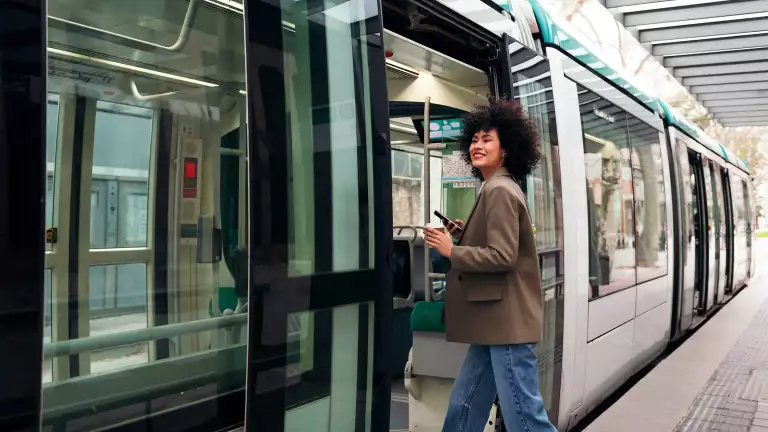Listen to this article
Climate change, driven primarily by greenhouse gas (GHG) emissions from fossil fuel combustion, poses an unprecedented threat to our planet.
The transportation sector, critical for economic and social growth, is also a leading contributor to emissions. Despite formidable challenges to decarbonization, the economic viability of low-carbon technologies has been increasing with the decreasing costs of EVs, renewable fuels, and alternative propulsion systems. Recent favorable policies and inspiring examples of transport decarbonization efforts worldwide are likely to enable markets to reach green parity earlier than previously expected.
The key to delivering results is a robust framework for the transportation sector’s decarbonization that focuses on three steps.
We argue that determined actions, supported by collaboration and policy implementation, can drive meaningful change in the transport sector. The key to delivering results is a robust framework for the sector’s decarbonization that focuses on three steps:
- Avoid unnecessary motorized travel and implement behavior change programs.
- Shift to less carbon-intensive modes.
- Improve the energy and carbon efficiency of vehicles.
This is known as the Avoid-Shift-Improve (ASI) framework. Measures to avoid and shift travel are especially effective and low cost in the long term and result in higher increases in well-being as co-benefits of GHG emissions reductions.
When applied, this framework can contribute to cleaner air, reduced noise, equitable access to transportation services, higher quality of life, and more livable cities. It also holds great promise for national and global efforts to combat climate change. (See “Climate Change by the Numbers.”)
Climate Change by the Numbers
1IPCC, AR6 Synthesis Report: Climate Change 2023.
2Matthew E. Kahn et al., Long-Term Macroeconomic Effects of Climate Change, IMF, 2019.
Transportation Is a Crucial Frontier in Decarbonization
Fossil fuel combustion by all modes of transportation—motorized land, sea, and air—and their associated activities is a major source of carbon dioxide (CO2) and other GHGs in the atmosphere. Indeed, the transport sector is the third largest contributor of global GHG emissions after the electricity generation and industrial
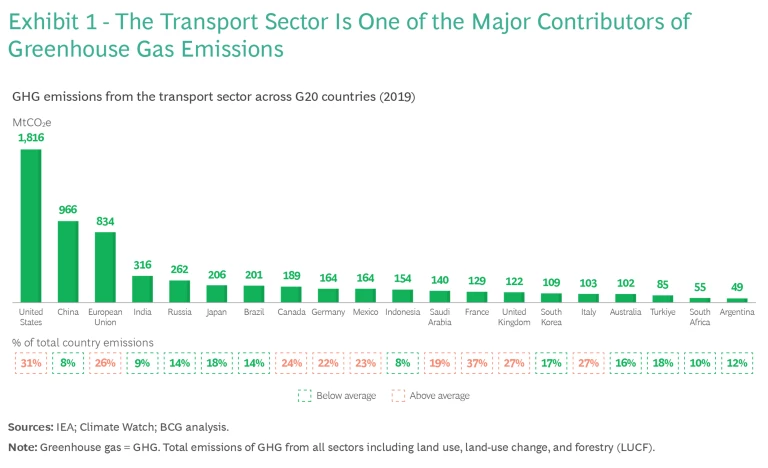
Exhibit 1 highlights the magnitude of transport sector emissions in some of the world’s largest economies. The sector accounts for well over a quarter of all emissions in the economies of North America and Europe. It is the largest emitting sector in the United Kingdom and the United States; in the European Union and the Kingdom of Saudi Arabia (KSA), it is the second largest.
There are 168 nationally determined contributions (NDCs) toward targets identified under the Paris Agreement at the NDC registry of the United Nations Framework Convention on Climate Change (UNFCCC). According to the International Transport Forum, some 98% of NDCs mention transport and 83% include transport
Five Challenges on the Journey to Decarbonizing Transport
The transport sector’s size and diversity make it challenging to decarbonize, particularly in aviation, shipping, and heavy transport. Common across geographies are the following five challenges. (See Exhibit 2.)
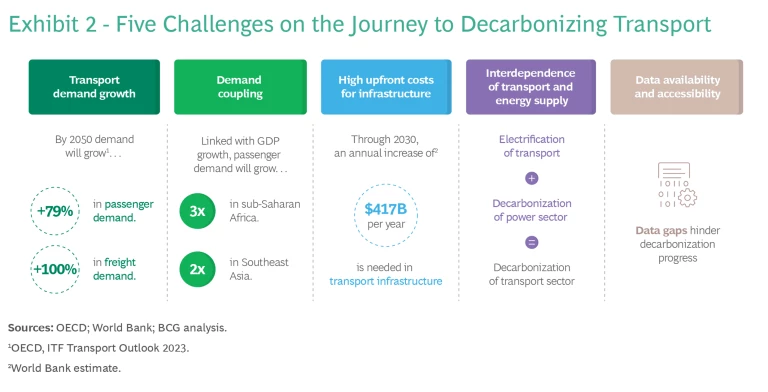
Expanding economies and populations increase the need for transportation services. The OECD’s International Transport Forum Transport Outlook 2023 report predicts that by 2050, passenger demand—measured as the transport of one person over a kilometer—could rise by 79%. Over the same period, freight demand—measured as the transport of one ton of goods over a kilometer—could double. This poses a significant risk of increased GHG emissions. Policymakers will play a crucial role in deploying technologies and implementing policies that shift transport quickly and effectively to more sustainable modes, offsetting the rapidly increasing demand.
Economic prosperity in Global South countries will likely result in higher transportation demand. Historically, for every $100 increase in GDP per capita in high-income countries, there has been a corresponding increase in inland travel by 44 passenger kilometers (pkm) per capita. (See Exhibit 3.) High-income countries have managed to decouple income growth from transportation demand growth to an extent through effective policy measures, modal shift initiatives, and investments in sustainable transport and cities. However, economic prosperity in the Global South will likely result in an even higher growth rate of transportation demand. For instance, passenger demand is expected to more than triple in sub-Saharan Africa and more than double in Southeast Asia by 2050. Considering that the carbon intensity of transportation lags vehicle sales by 10 to 15 years, quickly decoupling income growth from transportation demand in the Global South is essential to prevent future emissions surges. This effort will require further cross-country collaboration, targeted policies, and investments in sustainable infrastructure.
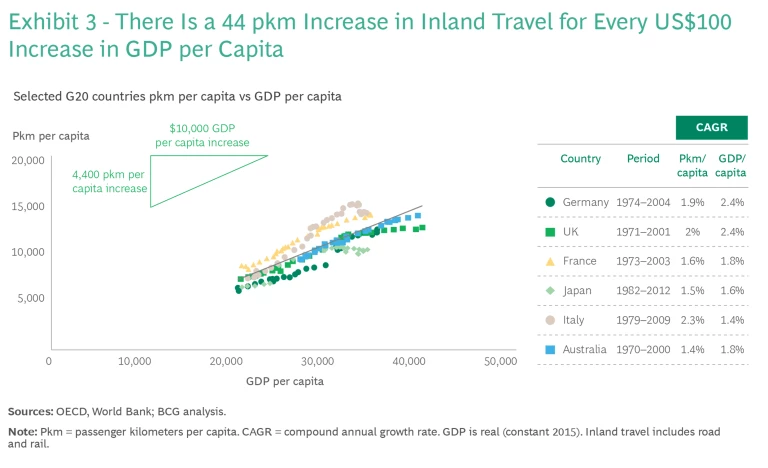
Transitioning to low-carbon technologies often entails substantial upfront costs, particularly in the Global South. The long-term benefits of these technologies can outweigh the costs, but accessing the initial capital required for the transition can be challenging. The World Bank’s estimates suggest that global investment in transport infrastructure must increase by approximately $417 billion annually through 2030 to meet the objectives set out in the Paris Agreement. Facilitating access to financial resources, establishing green investment funds, and leveraging international partnerships will be critical to securing the initial capital needed to transition to low-carbon alternatives. Furthermore, fostering an environment that enables private sector investments and innovative financing mechanisms is essential.
Transport decarbonization is deeply intertwined with the energy sector. Many low-carbon transport solutions, such as electric vehicles (EVs) and hydrogen-powered vehicles, rely directly or indirectly on electricity supply. Therefore, coordinated efforts to decarbonize both the transport and energy sectors while providing for the reliability and affordability of the electricity supply will play a significant role in shaping the environmental impact of transport decarbonization.
Data on transport emissions, climate impact along the value chain, and the effectiveness of various measures is often scattered and incomplete. This stands in the way of assessing progress accurately and leads to a lack of accountability for decarbonization efforts. Implementing robust data collection systems for GHG emissions for all modes, travel and vehicle types, locations, and whole life cycles and investing in advanced analytical tools and models can empower evidence-based policymaking and help track progress toward decarbonization goals.
The Good News Is That Green Cost Premiums Are Declining Rapidly
Despite the formidable challenges to decarbonization, promising advancements in technology and manufacturing have been made. These advancements are increasing the economic viability and diminishing the so-called “green cost premium” of low-carbon technologies by driving down the costs of EVs, renewable fuels, and alternative propulsion systems. The transition to low-carbon alternatives is becoming more attainable for consumers and businesses alike. By 2030, most low-carbon technologies are expected to be economically viable worldwide. The rapidly declining cost of low-carbon light-duty land transport this decade, which accounts for the majority of emissions, signals that economically competitive transport solutions are imminent. (See Exhibit 4.)
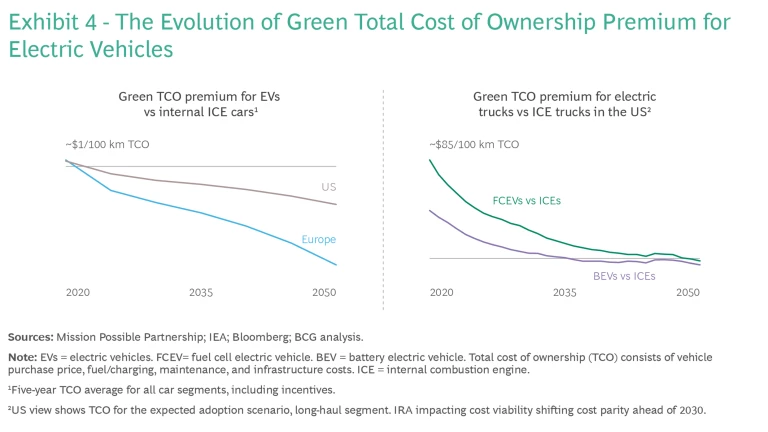
Politics will, too, play a critical role. Incentivizing the adoption of increasingly cost-effective technologies and implementing favorable regulatory frameworks, tax incentives, and grants for low-carbon vehicles and charging infrastructure can drive their uptake and substantially reduce transport-related GHG emissions.
Recent favorable policies such as the Inflation Reduction Act in the US, the EU’s Green Deal Industrial Plan, and Japan’s Green Transformation Basic Policy are likely to enable other markets to reach green parity earlier than previously expected. Building an effective ecosystem to encourage collaboration between research institutions, industries, and startups can also foster innovation and accelerate the development of affordable clean transportation technologies.
In maritime and aviation, the technology readiness levels of viable solutions are currently in stages 6 to 8—one step before systems are ready for operational deployment. An estimated $2.4 trillion in funding is needed for shipping to achieve net zero emissions by 2050; approximately $1.7 trillion will go toward alternative
Inspiring Decarbonization Strategies Are Emerging Around the World
The National Blueprint for Transportation Decarbonization, launched in 2023, is the US’ first whole-of-government approach to building a clean, safe, accessible, equitable, and decarbonized transportation system for all by
In 2021, the UK unveiled its 2050 transportation sector decarbonization plan, Decarbonising Transport: A Better, Greener
The UAE Smart Mobility Strategy aims to establish the UAE among the leading countries in smart intermodal mobility by 2032. It is structured around compatible infrastructure, integrated mobility systems, and dynamic policies and regulations and has five main objectives: safety, sustainability, efficiency, reliability, and a seamless experience.
Guided by strict climate goals to reach carbon neutrality by 2045, the German government follows a mixed technology approach to decarbonize the mobility sector by promoting both research and market activation for battery electric vehicles (BEVs), fuel cell electric vehicles (FCEVs), as well as alternative fuels, in a number of federal support programs across the value chain. In addition, the German Ministry of Transport operates two expert networks on sustainable and future-proof mobility, the National Platform Future of Mobility and the National Competency Network for Sustainable Mobility.
These ongoing efforts demonstrate how determined actions, supported by collaboration and policy implementation, can drive meaningful change in the transport sector. They reveal a robust framework to transport decarbonization focusing on three key steps: First, avoid unnecessary motorized travel and implement behavior change programs; then, shift to less carbon-intensive modes; and finally, improve the energy and carbon efficiency of vehicles. Measures to avoid and shift travel are especially effective and low cost in the long term and result in higher increases in well-being as co-benefits of GHG emissions reductions.
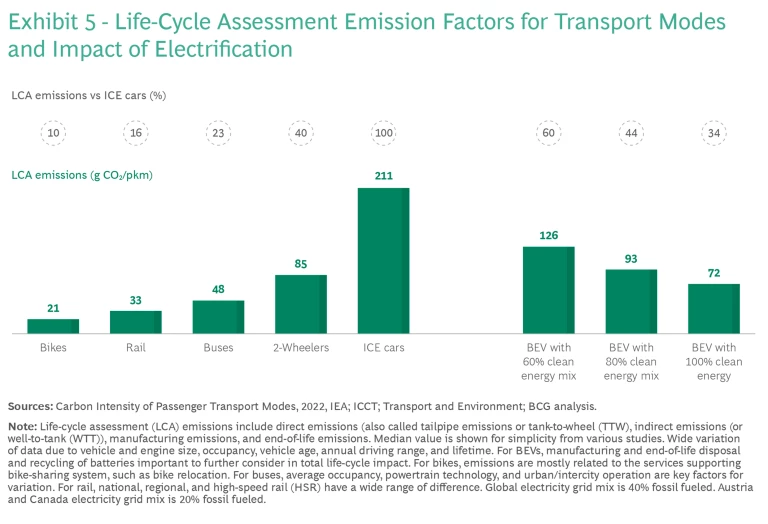
Life cycle assessment (LCA) emissions, including direct emissions (also called tailpipe emissions or tank-to-wheel), indirect emissions (or well-to-tank), manufacturing emissions, and end-of-life emissions, show that buses are 77% more carbon efficient than ICE cars in terms of grams of CO2 per
A Framework for the Sector’s Decarbonization
Research at the Massachusetts Institute of Technology shows that attitudes toward different modes of transportation affect travel
Step 1: Avoid. This step involves reducing GHG emissions from motorized transportation through demand management. When considering behavioral change, an important attitudinal factor is “car pride”—the social status associated with driving a car. A study of attitudes across 51 countries found that car pride is generally higher in Global South; Middle Eastern and Southeast Asian countries demonstrate the highest affinity overall, joined by the US as the exception among high-income
In Europe, 30%–50% of urban transport travel demand (expressed in pkm) is work-
Step 2: Shift. Modal shifts to less carbon-intensive transport are crucial to decarbonization efforts. Promoting collective transport such as trains or ridesharing and expanding public transport networks significantly reduce emissions. Car-sharing schemes, whether point-to-point or free-floating, also lead to reduced car ownership. Studies indicate that 5 to 15 cars could be replaced for each shared car added to a country’s fleet—an example of how one strategy can lead to both Shift and Avoid
Rail travel, in particular, holds promise in this step. Expanding railway infrastructure, improving operational efficiencies, and enhancing intermodal connectivity are crucial to facilitating a modal shift. The rail industry can play a vital role in the diversification of economies, promoting GDP growth by offering an alternative method of ground transportation that is more environmentally friendly and sustainable.
Step 3: Improve. This final step involves enhancing vehicle design, improving energy and carbon efficiency, and diversifying energy sources. Authorities engaged in shaping transport regulations and standards have the power to drive improvements in vehicle efficiency and promote the adoption of low-carbon technologies. Establishing stringent fuel economy standards, fostering research and development in lightweight materials, aerodynamics, and energy-saving technologies, and incentivizing the use of renewable energy sources in transport will be essential. Further, creating a supportive ecosystem for producing and adopting low-carbon vehicles is crucial.
More than 500 electric car models are currently on the market, more than double the number available in 2018, representing increased choice and affordability for
Importantly, each measure under the ASI framework varies in its GHG reduction potential, cost, and socioeconomic impact. Exhibit 6 demonstrates how the abatement potential curve under the ASI framework could progress until 2050, illustrating that the modal shift to public and active transport and electrification of land transportation could have the highest impact. Avoid and Shift measures, which are more localized in their impact than Improve measures, can account for reducing up to 60% of transport emissions and often come with lower costs. However, despite their potential, the updated NDCs under the Paris Agreement focus overwhelmingly on Improve measures—50% of all actions outlined—while Avoid measures account for only 10%.
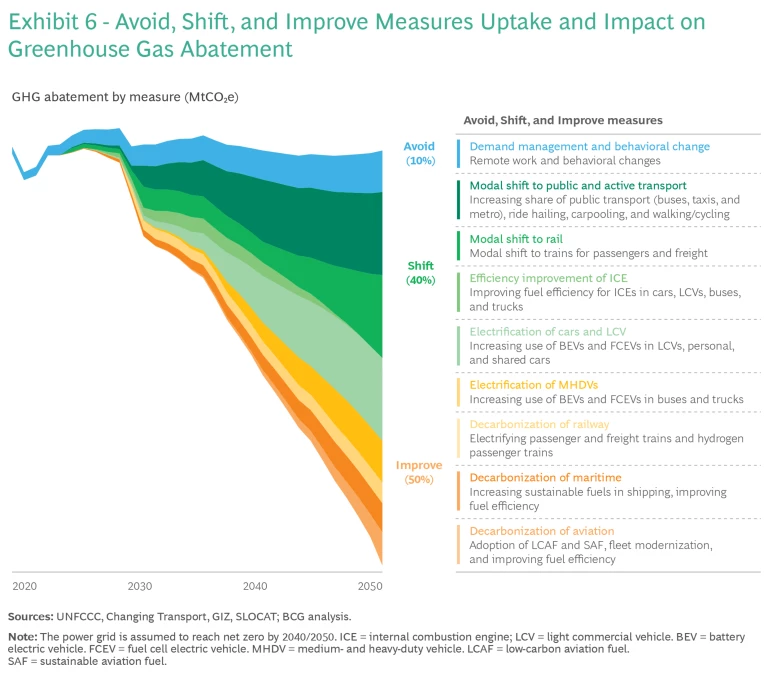
To ensure the successful, integrated implementation of the ASI framework, officials and decision makers must consider advanced analytical tools and models, coupling the transport and power sectors, just and equitable transition strategies, and multilevel governance. By capitalizing on these considerations and the positive business case for decarbonization, they can secure a more sustainable way forward. (See “Examples of Regulations and Initiatives Supporting the Decarbonization Framework.”)
Examples of Regulations and Initiatives Supporting the Decarbonization Framework
Avoid
- The EU and governments around the world, including Australia, Argentina, and the Philippines, have introduced teleworking or flexible working laws and regulations. Recently, Kingdom of Saudi Arabia’s (KSA’s) Ministry of Human Resources and Social Development approved the introduction of work-from-home policies in public sector entities.1
- The updated land transportation policies set under the Transportation Master Plan for Qatar 2050 encourage nonmotorized transport, including walking, cycling, and small-wheeled transport, to reduce congestion and pollution levels and promote physical activity. In the United Arab Emirates (UAE), Dubai’s Roads and Transport Authority (RTA) has laid 527 km of cycling tracks across the city and plans to nearly double the current size of its bicycle-sharing program by deploying 3,000 bicycles at 350 stations over the next few years.2
Shift
- The EU has set a bold ambition to double freight rail’s modal share to 30% by 2030 to reduce the transport sector’s GHG emissions and ease congestion of major road connections.3
- In the six-nation Gulf Cooperation Council (GCC), the rail sector is rapidly evolving and presents an example of accelerated development to decarbonize the transport sector. At an estimated cost of $250 billion, the GCC Railway Project is set to be one of the world’s largest contemporary cross-border rail networks.4 It will link key cities within the UAE, KSA, Qatar, Kuwait, Bahrain, and Oman into an integrated, pan-Arabian route of more than 2,172 km while handling up to half of the 61 million tons of cargo transported within the region annually across all modes of transport.
- The German federal government has undertaken initiatives to transition toward climate-friendly transportation systems. In May 2023, it introduced a universal flat-rate rail ticket applicable to all regional rail services as well as other forms of public transportation, including buses and subways. This initiative represents an annual investment of 1.5 billion euros. The flat-rate ticket, priced at 49 euros per month, has already attracted approximately 11 million subscribers, accounting for roughly 13% of Germany’s total population. According to a survey conducted among passengers, 8% of the subscribers reported shifting from exclusive car use to rail and public transportation as a direct result of the flat-rate ticket.5
- Based on traffic volume forecasts, the 1,200 km Etihad Rail network in the UAE will reduce GHG emissions by more than 2.2 million tons annually once fully operational—the equivalent of taking as many as 375,000 vehicles off the roads.6 In KSA, a planned expansion of the rail network to 8,000 km of track, plus a 1,300 km land bridge project to connect domestic seaports on the Gulf coast with those on the Red Sea, would have the capacity to transport more than 3 million passengers and some 50 million tons of freight per year while curbing transport-related GHG emissions, which account for 19% of the country’s overall emissions.7
Improve
- Examples of policies pointing in the right direction include the US Environmental Protection Agency’s recent proposal of federal vehicle emissions standards that will prevent nearly 10 billion tons of CO2 emissions through 2055 and yield roughly $1 trillion in benefits over any associated costs.8
- Through its ReFuelEU regulation, the EU has mandated all flights departing from airports in the region to use a minimum of 2% Sustainable Aviation Fuels from 2025. That share will rise to 6% by 2030 and gradually to 70% by 2050.9
- Recent examples from the Middle East include the RTA’s Zero-Emissions Public Transportation in Dubai 2050 plan, the first of its kind in the Middle East, which will leverage clean energy sources and electrification among other initiatives to decarbonize the sector over the long term.10 In Abu Dhabi, Etihad Airways tested its first “sustainable flight” in October 2021 as part of its net zero emissions by 2050 goal. Powered by almost 40% sustainable fuels, sustainable flights can reduce primary carbon emissions by 72% and use 80% fewer single-use plastics on board.11 In KSA, investments in auto manufacturers Lucid and Ceer are set to localize the EV industry and boost in-country sustainability, shifting 30% of all new car sales in Riyadh to EVs by 2030 and electrifying public transport vehicles.12
2“RTA, Careem Launch Phase II of Bike Rental Service,” news release, Government of Dubai Media Office, March 6, 2022.
3European Commission, Transport 2050.
4Ghazanfar Ali Khan, “EU, GCC Sign MoU on Railway Cooperation,” Arab News, January 12, 2017.
5“Ein Ticket für ganz Deutschland,” German government (“Bundesregierung”) website, January 29, 2024.
6“UAE-Oman Link to Lower Trading Costs, Says Etihad Rail Executive,” Arabian Business, January 12, 2023.
7“SAR Seeks Partners to Expand Its Rail Network,” Rail Pro website, September 21, 2022; “What Is Saudi Arabia’s Pathway to Limit Global Warming to 1.5°C?” Climate Analytics website, 2022.
8“Biden-Harris Administration Proposes Strongest-Ever Pollution Standards for Cars and Trucks to Accelerate Transition to a Clean-Transportation Future,” press release, US Environmental Protection Agency, April 12, 2023.
9“European Green Deal: New Law to Cut Aviation Emissions by Promoting Sustainable Aviation Fuels,” press release, European Commission, April 26, 2023.
10“RTA Rolls Out Strategy to Transition to Zero-Emissions Operations by 2050,” Government of Dubai Media Office website, March 28, 2023.
11Jacopo Prisco, “Etihad’s ‘Greenliner’ Shows a Glimpse of a More Sustainable Future for Aviation,” CNN.com, December 9, 2022.
12“Saudi Arabia Seeks to Turbocharge Electric Vehicle Industry,” Economist Intelligence Unit website, 2023.
Tools for Successful Decarbonization in Transport
To ensure the successful, integrated implementation of the ASI framework, officials and decision makers need to consider the following:
Analytical Tools and Models. The data availability and accessibility challenge is a major factor hindering the development of efficient policy instruments. Addressing the inability to tap into large pools of available GHG emissions data and gaps in the measurement of results is key. Advanced analytical tools and models can be used to conduct comprehensive baseline assessments, data analytics, scenario analyses, cost evaluations, and socioeconomic impact assessments. They also provide invaluable insights for evidence-based decision making. In particular, the growing competency of AI-powered analytics can rapidly streamline data collection, interpretation, and policy formulation processes and facilitate effective carbon-emission reduction measures.
Coupling the Transport and Power Sectors. Like the heating/cooling and industrial sectors, the transport sector is a significant energy consumer. The electrification of transport, coupled with power sector decarbonization, will be essential to GHG emissions reduction programs worldwide. According to the International Renewable Energy Agency, unlocking the full potential of sector coupling will involve smart charging infrastructure for EVs, exploring vehicle-to-grid technology, and promoting vehicle-to-building applications to ensure the efficient utilization of renewable energy, peak demand reduction, improved system resilience, and enhanced integration of variable renewable energy sources. This can be achieved through collaboration to coordinate investments, align regulatory frameworks, and promote cross-sectoral partnerships to increase the flexibility and reliability of direct and indirect electricity use across the transportation ecosystem.
Just and Equitable Transition Strategies. As high-income countries clean up their fleets with EVs, low- and middle-income countries lacking competitive alternatives will bear the burden of shifting away from fossil fuel-based systems. Similarly, low-income groups within any economy may face financial challenges in acquiring electric and low-carbon vehicles due to their higher initial costs, exacerbating social inequality. To address this, a global approach to a fair and just transition is required to tackle the flood of second-hand fossil fuel-powered vehicles into international trade flows. As one of the leading funds to fast track Global South countries’ transition to greener, more sustainable transport, the World Bank’s Global Facility to Decarbonize Transport may be pivotal in addressing the green transport divide. However, according to the IPCC, progress on the alignment of financial flows toward the goals of the Paris Agreement remains slow, and tracked climate finance flows are distributed unevenly across regions and sectors. Progressive pricing systems for public transport, affordable financing schemes for clean vehicles, and subsidies or incentives for low-income individuals to access low-carbon transportation options should be implemented at the local level. A prime example of an equitable approach is the city of Vienna’s transport policy, which in 2012 incentivized rail and tram travel through a pricing structure in which yearly tickets cost just one euro per day. As a result, the mode share of public transport increased at five times the annual growth rate of the previous decade to 39% in
Multilevel Governance. The governance ecosystem behind transportation is diverse and fragmented, with each economy manifesting its hierarchy of public officials, regulators, city authorities, and municipalities to manage various aspects of the sector. A whole-of-government approach is required to ensure comprehensive coordination and collaboration across ministries, departments, cities, and agencies. Establishing efficient vertical and horizontal coordination mechanisms can streamline decision making and drive policy coherence. Efforts to enact multilevel governance include the US government’s Joint Office of Energy and Transportation, which is mandated to break down silos in the energy and transport sectors to accelerate progress on key emissions reduction initiatives. The EU’s Directorate for Energy, Transport and Climate supports policies and technological innovation to ensure safe, efficient, and sustainable energy and transport in all member nations.
Seizing the Decarbonization Advantages
The challenges to decarbonizing the transport sector might seem significant, but the advantages of pursuing the opportunity for a sustainable future are vast.
Economic and Environmental Advantages. Decarbonizing the transport sector can drive economic growth, create jobs, and stimulate innovation. Local economies can be bolstered by investing in clean transportation technologies and infrastructure while enhancing their contribution to combatting climate change. Cleaner air, reduced traffic congestion, and improved public health are additional benefits that enhance the quality of life for all.
Resilient and Efficient Systems. A decarbonized transport system fosters resilience, adaptability, and preparedness for the uncertainties of a changing climate. EVs, fuel-efficient technologies, and smart infrastructure can enhance the efficiency and reliability of transport networks, reducing the sector’s vulnerability to supply chain disruptions and oil price fluctuations.
Social Inclusivity. Decarbonizing transport through the provision of accessible and affordable mobility options for all can ensure that no one is left behind. Prioritizing public transport, nonmotorized travel, and innovative shared mobility solutions can also create a more equitable transport system, improving access to education, health care, and job opportunities.
To secure a sustainable path forward, transport authorities must capitalize on the positive business case for decarbonization.
Decisive action to implement the above-mentioned measures can steer the transport sector toward a low-carbon future, delaying and even mitigating looming irreversible climate impacts. As one of the most critical sectors in the race to limit the planet’s temperatures from rising beyond 1.5°C, transport and its road ahead carries far-reaching implications for the well-being of communities, energy security, and economic growth. To secure a sustainable path forward, transport authorities must capitalize on the positive business case for decarbonization, ensure a just and equitable transition, leverage advanced analytical tools and models, and adopt a whole-of-government approach. The moment we are in demands it; the future depends on it.
